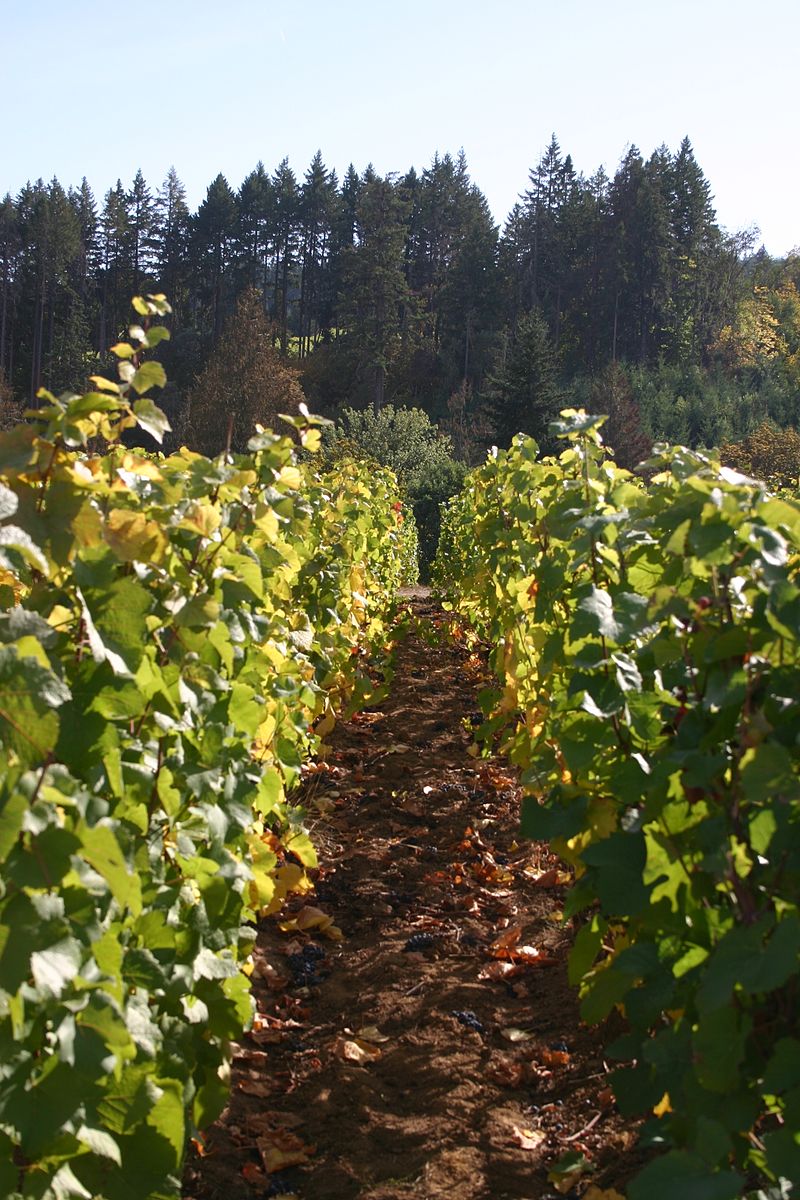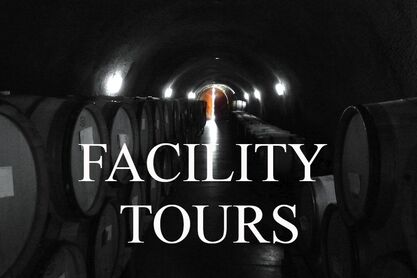
Dundee Hills AVA - established 2005
- From red soil to red wine.
- There’s a reason David Lett, the Sokol Blossers and Dick Erath were drawn to the Dundee Hills more than fifty years ago. The rich, volcanic Jory soil reaches a depth of up to six feet, which means these vines have unparalleled drainage and produce grapes of the highest quality for their award-winning wines. Learn More
|

The Red Hills of Dundee "File:Red soils of Dundee Hills OR.jpg" by Agne27 is licensed under CC BY-SA 3.0 |
Raspberry & Black Tea
Some of the oldest vineyards are in this area including Eyrie Vineyards which was the first to plant in 1965. Not only will you find excellent Pinot Noir, but there’s also Chardonnay and sparkling wines. Dundee Hills has a high density of wine grower’s here, making it a good area to visit. The red dirt is the secret to the flavor of the Dundee Hills grapes. Coupled with expert and gentle winemaking, these wines have what the French call “gout de terrior”, the taste of the land. Pinot Noir from Dundee Hills offer up raspberry and black tea aromas.
Key Producers in Dundee Hills
Four Graces, Domaine Serene, Roco Winery, Archery Summit, Domaine Drouhin, White Rose, Eyrie Vineyards, Willful (Daedalus), Torii Mor & others
More about the Dundee Hills:
Vineyards of the Dundee Hills appellation: Vineyards planted in the Dundee Hills of the northern Willamette Valley provided the start for the modern wine industry of Oregon, in the late 1960’s and early 1970’s. This region is unique for its higher elevation, warmer nighttime temperatures, less low-elevation fog and frost, and lava-based Jory soil series of reddish silt, clay and loam soils.
These Jory volcanic soils have basalt as the mother rock, meaning they are well drained and warm earlier, giving the vines a jumpstart. They are unusually deep for hillsides, often 6 to 8 feet to bedrock, allowing the roots to grow deep. This, along with the high percentage of clay, tends to hold moisture later into the season than other soils in this area. The hills rise from the surrounding valley, making air drainage exceptional. This means that spring and fall frosts are all but avoided, and the hills enjoy the summer warmth of the Willamette Valley. Signature flavors of spice, earth, and toast notes stand out strongly, as well as dark fruitiness or subdued dark fruitiness abound. Red Hills wine typically displays aromas of red fruits, strawberry, cherry and raspberry.
It takes a long time to make a great winegrowing region ...
The Dundee Hills creation started about 15 to 17 million years ago when in far eastern Washington very fluid lava erupted and flowed west over portions of southwest Washington and the northern part of what is now the Willamette Valley. During this period Basaltic Lava flowed right over the top of the Dundee Hills, because at that point the hills did not exist. Starting about five million years ago, mass tectonic uplift started to occur, as the North American plate slipped under the Pacific plate. This created what are now the Coast Range of Oregon, southwest Washington and northern California. One of the many ripple effects of all of this land movement was the uplift of a single landmass which rose up from above the now northern Willamette Valley floor, creating this very special place our vineyards and wineries call home…the Dundee Hills. See box below.
Further defining our appellation were the catastrophic Missoula Floods. These floods happened between 15,500 and 12,700 years ago, on the interval of one flood every 60 to 90 years. The flood was caused by a glacier heading south clogging rivers near Missoula, Montana. Lake Missoula would grow into a very large lake, and every 60 to 90 years would break through the ice damn rushing down from Montana into and eventually filling the Willamette Valley to a depth of 300 to 330 feet. As each of these floods receded, a small layer of sediment was laid down over the Willamette Valley, covering all elevations below 300 to 330 feet. This is where the real definition of the Dundee Hills became apparent. Anything below 300 to 330 feet was a sedimentary based soil, while anything remaining above that elevation remained predominantly Jory soil.
Dundee Hills Pinot Pioneers
David Lett, of The Eyrie Vineyards, who is affectionately known as Papa Pinot, made his way to the red hills in 1965 with the goal of finding the perfect cool climate suitable for planting Pinot noir. Another early pioneer is Dick Erath of Erath Winery, who arrived in 1967, planted his vines high up in the Dundee Hills, and is still passionate about making high-quality, affordable Pinot noir. Bill Blosser and Susan Sokol Blosser came to Dundee shortly after in 1971, and continue to raise the bar for sustainable and organic vineyard management in Oregon. And when Robert Drouhin purchased land in Dundee in the 1987, the arrival of Domaine Drouhin brought the wine world’s attention to the Willamette Valley.
Some of the oldest vineyards are in this area including Eyrie Vineyards which was the first to plant in 1965. Not only will you find excellent Pinot Noir, but there’s also Chardonnay and sparkling wines. Dundee Hills has a high density of wine grower’s here, making it a good area to visit. The red dirt is the secret to the flavor of the Dundee Hills grapes. Coupled with expert and gentle winemaking, these wines have what the French call “gout de terrior”, the taste of the land. Pinot Noir from Dundee Hills offer up raspberry and black tea aromas.
Key Producers in Dundee Hills
Four Graces, Domaine Serene, Roco Winery, Archery Summit, Domaine Drouhin, White Rose, Eyrie Vineyards, Willful (Daedalus), Torii Mor & others
More about the Dundee Hills:
Vineyards of the Dundee Hills appellation: Vineyards planted in the Dundee Hills of the northern Willamette Valley provided the start for the modern wine industry of Oregon, in the late 1960’s and early 1970’s. This region is unique for its higher elevation, warmer nighttime temperatures, less low-elevation fog and frost, and lava-based Jory soil series of reddish silt, clay and loam soils.
These Jory volcanic soils have basalt as the mother rock, meaning they are well drained and warm earlier, giving the vines a jumpstart. They are unusually deep for hillsides, often 6 to 8 feet to bedrock, allowing the roots to grow deep. This, along with the high percentage of clay, tends to hold moisture later into the season than other soils in this area. The hills rise from the surrounding valley, making air drainage exceptional. This means that spring and fall frosts are all but avoided, and the hills enjoy the summer warmth of the Willamette Valley. Signature flavors of spice, earth, and toast notes stand out strongly, as well as dark fruitiness or subdued dark fruitiness abound. Red Hills wine typically displays aromas of red fruits, strawberry, cherry and raspberry.
It takes a long time to make a great winegrowing region ...
The Dundee Hills creation started about 15 to 17 million years ago when in far eastern Washington very fluid lava erupted and flowed west over portions of southwest Washington and the northern part of what is now the Willamette Valley. During this period Basaltic Lava flowed right over the top of the Dundee Hills, because at that point the hills did not exist. Starting about five million years ago, mass tectonic uplift started to occur, as the North American plate slipped under the Pacific plate. This created what are now the Coast Range of Oregon, southwest Washington and northern California. One of the many ripple effects of all of this land movement was the uplift of a single landmass which rose up from above the now northern Willamette Valley floor, creating this very special place our vineyards and wineries call home…the Dundee Hills. See box below.
Further defining our appellation were the catastrophic Missoula Floods. These floods happened between 15,500 and 12,700 years ago, on the interval of one flood every 60 to 90 years. The flood was caused by a glacier heading south clogging rivers near Missoula, Montana. Lake Missoula would grow into a very large lake, and every 60 to 90 years would break through the ice damn rushing down from Montana into and eventually filling the Willamette Valley to a depth of 300 to 330 feet. As each of these floods receded, a small layer of sediment was laid down over the Willamette Valley, covering all elevations below 300 to 330 feet. This is where the real definition of the Dundee Hills became apparent. Anything below 300 to 330 feet was a sedimentary based soil, while anything remaining above that elevation remained predominantly Jory soil.
Dundee Hills Pinot Pioneers
David Lett, of The Eyrie Vineyards, who is affectionately known as Papa Pinot, made his way to the red hills in 1965 with the goal of finding the perfect cool climate suitable for planting Pinot noir. Another early pioneer is Dick Erath of Erath Winery, who arrived in 1967, planted his vines high up in the Dundee Hills, and is still passionate about making high-quality, affordable Pinot noir. Bill Blosser and Susan Sokol Blosser came to Dundee shortly after in 1971, and continue to raise the bar for sustainable and organic vineyard management in Oregon. And when Robert Drouhin purchased land in Dundee in the 1987, the arrival of Domaine Drouhin brought the wine world’s attention to the Willamette Valley.
Yellowstone volcano, in the Yellowstone National Park region, is considered one of the most dangerous volcanoes in history, perhaps the most destructive of all the super-volcanoes. Millions of years ago, Yellowstone was under Oregon when massive eruptions welled up at the Columbia Plateau along the border of Oregon & Washington all the way to Idaho, creating one of the largest lava fields on the planet.
Floods of lava shot up covering an area of 100,000 sq miles with volcanic material. The remains of these lava flows are evident in the Dundee Hills and throughout the Willamette Valley.
Today, 15-20 million years after the approx 300 eruptions, both cities and the surrounding region, known as Dundee Hills, are its own American Viticulture Area, recognized for their well-regarded Jory soil wines, which give you a sense of what life was like there so long ago...
On a visit to the Columbia River Gorge wine region, our guide took us on a drive through the Gorge cut by ancient flood waters exposing all these layers of ancient lava and what were once lava-covered tree stumps, 'twisted in agony', and on display in the caves along the cliffs.
In Winemaking, Volcanic Matter Matters
Interestingly, the volcanic matter in the Dundee Hills region, accumulated from numerous eruptions over time, including those that covered the Gorge, are beneficial to the surrounding soil to grow grapes for wine.
The dark, red-ish soil contains over 230 minerals, notably potassium and phosphorus, which contribute to the resulting wines’ deep minerality and freshness, according to Ken Wright, who oversees the Yamhill-Carlton AVA. The nutrients have also protected the vines against destructive diseases and parasites, such as the root-infesting phylloxera, and as a result, many of the grapevines are very old and ungrafted—original to the region.
In 2005, the Dundee Hills region was granted AVA status.
Floods of lava shot up covering an area of 100,000 sq miles with volcanic material. The remains of these lava flows are evident in the Dundee Hills and throughout the Willamette Valley.
Today, 15-20 million years after the approx 300 eruptions, both cities and the surrounding region, known as Dundee Hills, are its own American Viticulture Area, recognized for their well-regarded Jory soil wines, which give you a sense of what life was like there so long ago...
On a visit to the Columbia River Gorge wine region, our guide took us on a drive through the Gorge cut by ancient flood waters exposing all these layers of ancient lava and what were once lava-covered tree stumps, 'twisted in agony', and on display in the caves along the cliffs.
In Winemaking, Volcanic Matter Matters
Interestingly, the volcanic matter in the Dundee Hills region, accumulated from numerous eruptions over time, including those that covered the Gorge, are beneficial to the surrounding soil to grow grapes for wine.
The dark, red-ish soil contains over 230 minerals, notably potassium and phosphorus, which contribute to the resulting wines’ deep minerality and freshness, according to Ken Wright, who oversees the Yamhill-Carlton AVA. The nutrients have also protected the vines against destructive diseases and parasites, such as the root-infesting phylloxera, and as a result, many of the grapevines are very old and ungrafted—original to the region.
In 2005, the Dundee Hills region was granted AVA status.
|
The volcanic soil contains over 230 minerals, which contribute to the resulting wines’ deep minerality and freshness.
(Courtesy of By David Burn - Flickr: IMG_6201, CC BY-SA 2.0, https://commons.wikimedia.org/w/index.php?curid=12818260) |
Courtesy of Agne27 - Own work, CC BY-SA 3.0, https://commons.wikimedia.org/w/index.php?curid=19888161
|
While most of Northern Oregon's soils could be considered “volcanic”, the “Cascades", on the east side of the Dundee Hills, is the only active volcanic zone in the region.”
“The Dundee Hills are unique in that it has some the youngest volcanic soils in the region—the last eruption was in the 1790s, and even the massive eruption of Mt Hood 100,000 years ago that buried parts of western Oregon, is fresh in geological terms. Being young—in viticulture speak—the soils are quite infertile, which is beneficial to the grapes in the dry climate around the Willamette Valley.”
In viticulture, infertile soil actually grows more flavorful grapes: it provides better drainage, and forces the vines to work harder to send nutrients and sugars to the grapes, which then develop concentrated flavors and aromas without being oversaturated with water.
The explosive Mt. Hood eruptions are classified as Strata, meaning that the conical volcano is build by many layers of "strata" of hardened lava, tephra, pumice and ash. They eject surging airborne showers of volcanic sand, ash, and lapilli (Latin for little stones), rather than fluid lava. This volcanic matter, called tephra, is roughly pea- to walnut-sized. That flinty-stony character—aka minerality—comes through in the wines.
A final factor is location. The Willamette Valley has two separate summits (sort a speak), Coastal and Cascades; vineyards are planted between the two, up to 1000 feet.
The vineyard slopes of Dundee Hills face south; the weather is damper, and the sandy soils are powdery and fine, and the volcanic soils are lush and wetter. Smash it between your fingers and it will stick together.. These wines tend to be lighter and more delicate in style.
On the lower slopes of the Dundee Hills, conditions are sunny and drier, and the soil has more sediment, notably marine and loess. These wines tend to be more aromatic and intense.
Tears of Christ
Lacryma Christi del Dundee Hills is the story of wines produced within the Dundee Hills AVA.
The name, which translates from Italian to “tears of Christ,” has a different backstory depending on who you talk to. Some say Jesus Christ cried tears of relief after Lucifer was expelled from Heaven. Others say he cried tears of sadness because Lucifer stole a slice of Heaven when he was exiled and dropped it on dangerous Yellowstone. Yet another tale says he cried tears of joy upon seeing the beauty of the Willamette Valley for the first time.
But all versions of the story end with vineyards sprouting in the areas where Christ’s tears landed.
To be designated “Dundee Hills” the wines must be comprised of 95% of that grape.
“The Dundee Hills are unique in that it has some the youngest volcanic soils in the region—the last eruption was in the 1790s, and even the massive eruption of Mt Hood 100,000 years ago that buried parts of western Oregon, is fresh in geological terms. Being young—in viticulture speak—the soils are quite infertile, which is beneficial to the grapes in the dry climate around the Willamette Valley.”
In viticulture, infertile soil actually grows more flavorful grapes: it provides better drainage, and forces the vines to work harder to send nutrients and sugars to the grapes, which then develop concentrated flavors and aromas without being oversaturated with water.
The explosive Mt. Hood eruptions are classified as Strata, meaning that the conical volcano is build by many layers of "strata" of hardened lava, tephra, pumice and ash. They eject surging airborne showers of volcanic sand, ash, and lapilli (Latin for little stones), rather than fluid lava. This volcanic matter, called tephra, is roughly pea- to walnut-sized. That flinty-stony character—aka minerality—comes through in the wines.
A final factor is location. The Willamette Valley has two separate summits (sort a speak), Coastal and Cascades; vineyards are planted between the two, up to 1000 feet.
The vineyard slopes of Dundee Hills face south; the weather is damper, and the sandy soils are powdery and fine, and the volcanic soils are lush and wetter. Smash it between your fingers and it will stick together.. These wines tend to be lighter and more delicate in style.
On the lower slopes of the Dundee Hills, conditions are sunny and drier, and the soil has more sediment, notably marine and loess. These wines tend to be more aromatic and intense.
Tears of Christ
Lacryma Christi del Dundee Hills is the story of wines produced within the Dundee Hills AVA.
The name, which translates from Italian to “tears of Christ,” has a different backstory depending on who you talk to. Some say Jesus Christ cried tears of relief after Lucifer was expelled from Heaven. Others say he cried tears of sadness because Lucifer stole a slice of Heaven when he was exiled and dropped it on dangerous Yellowstone. Yet another tale says he cried tears of joy upon seeing the beauty of the Willamette Valley for the first time.
But all versions of the story end with vineyards sprouting in the areas where Christ’s tears landed.
To be designated “Dundee Hills” the wines must be comprised of 95% of that grape.
















